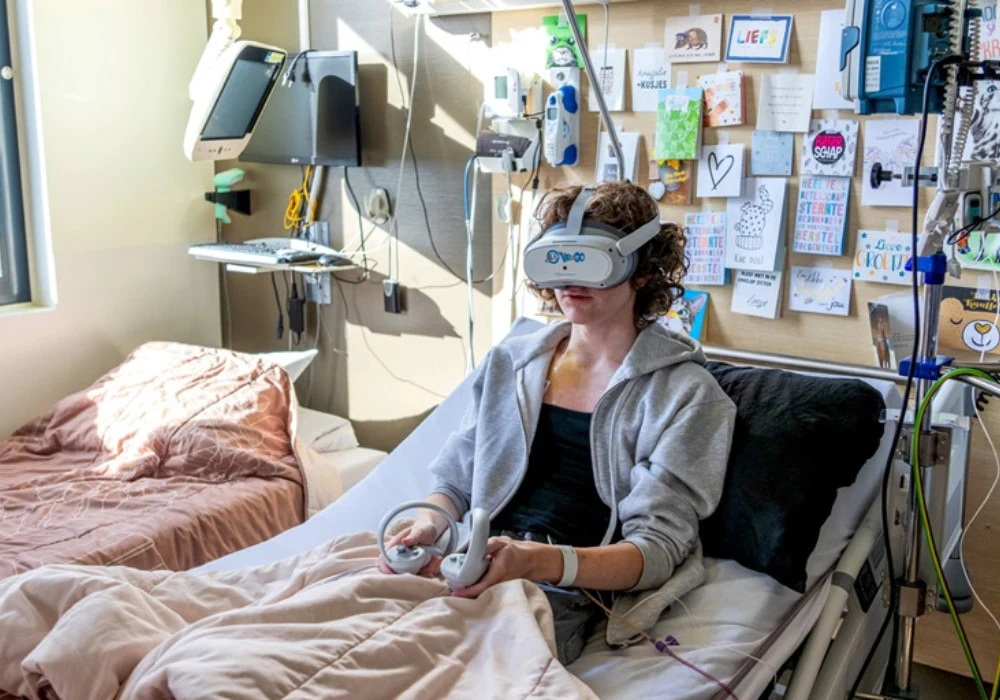“With these on, I can relax and escape from here without physically leaving,” Yoran says as he puts on a virtual reality (VR) headset provided by his medical team. Yoran is one of over 100 000 yearly patients at the Radboud University Medical Center (Radboudumc) in Nijmegen, Kingdom of the Netherlands, and a teenager who enjoys what most teenagers do. It just so happens that he needs medical assistance to digest food.
During long-term stays at the hospital, his VR headset offers a choice of activities, ranging from games with physical movement to mindfulness and meditation practices. “My favourite game is the one where they put a ball in 1 of 3 cups, shuffle them, and I guess where the ball is,” he says, still engrossed in the game.
Patients like Yoran have been benefiting from state-of-the-art digital health solutions at Radboudumc since 2022, when the hospital invested in a large-scale digitalization revamp. These technologies are reshaping health care by offering patients a more comfortable experience and aiding health professionals in delivering more personalized care.
A new approach for comfort and healing
Patients, particularly those facing prolonged hospital stays, often experience stress, anxiety and discomfort. Traditionally, sedation and medication have been the primary tools to manage these issues. However, recent advancements in digital technology are changing patient experiences, offering an alternative that not only alleviates stress and pain but also brings a sense of normalcy.
Apart from VR, Radboudumc employs digital tablets and smartphones that patients use to customize their stay. By just touching the screen and without leaving the bed, a person can control lighting in their room, adjust the curtains, and even invite fellow patients and staff to come in for a chat via a digital door sign outside.
A remarkable aspect of VR technology is its dual functionality: not only does it provide entertainment, but it can also help health and care professionals to connect with their patients on a deeper level. For example, a nurse can, with mutual agreement, view the content simultaneously through an interconnected device. This allows them to engage in conversations and guide the patient through game scripts, creating a bond that goes beyond standard patient-caregiver interactions.
“A few years ago, we had a patient in the trauma ward who had suffered a very severe accident. Almost all her bones were broken. We encouraged her to try VR for therapy,” a nurse at Radboudumc recalls.
“She chose a script about swimming with dolphins. Even though she was wearing this large headset, you could still see the emotions on her face. It brought her to tears. Afterwards, she told me that she used to go snorkelling on holidays but had to stop due to health issues. Her favourite memory was swimming together with a mother dolphin and its baby. And now she was able to relive that beautiful memory in VR.”
Digital solutions for the youngest patients
Valuing the window to the outside world that digital technology can offer, Radboudumc decided to make VR accessible even for babies who are too young to wear headsets. Instead, the youngest patients can experience the world through digital ceilings.
As the nurse dims the lights and colourful butterflies appear on the ceiling, a smile creeps across the face of 5-month-old baby Sef. He is silent and completely mesmerized. No technology can replace a real outdoor experience, but when all of life is contained by hospital walls, it just might be the next best thing.
Another nurse recounts the story of a child who spent their entire first year at Radboudumc. The digital ceiling helped them explore new worlds and stimulate important sensory experiences.
“That baby had never been outside the hospital. It was their whole life,” the nurse says. “But watching the digital ceiling made them very happy. We love to see babies happy, but, more importantly, it makes them comfortable – because the hospital can be a very stressful environment. These digital solutions can alleviate the discomfort for the whole family.”
Looking ahead
Sanne van Alphen, Nursing Information Officer at Radboudumc, hopes that eventually technology will not just enhance a hospital stay for patients, but also shorten it. “Maybe someday digital tools will enable our patients to go home sooner and receive care remotely, at home with their families where they belong. As digital health evolves, perhaps there won’t be a need for children and adults to stay here for so long. I don’t think anyone wants to be in a hospital, no matter how nice it is.”
She also hopes for more seamless communication and data exchange between different facilities. “A patient’s doctor at home should be able to provide information to our hospital or any other hospital, so that we wouldn’t need to ask the patient to recite their entire medical history. We spend so much time piecing this information together, and we’d rather spend more time with the patients. I hope that digital tools can make it easier.”
What Sanne describes is called interoperability. It means that health information systems can connect and exchange information with each other across national and international boundaries. For health information systems to be impactful and cost-effective, they need secure, consistent and well structured data.
WHO/Europe support
WHO/Europe’s report “Digital health in the WHO European Region: the ongoing journey to commitment and transformation” found that 43 Member States see improving health information sharing and interoperability as strategic priorities.
In 2023 WHO/Europe and the European Commission launched a joint project to strengthen health information systems and boost health data governance and interoperability in the 53 countries of the Region.
“The digital solutions available to patients and care providers today would have seemed like something straight out of science fiction just a decade ago. This makes us excited and hopeful about what future innovation brings,” said David Novillo Ortiz, WHO/Europe’s Regional Adviser for Data and Digital Health.
“WHO/Europe is here to guide the digital transformation and ensure that all countries in our Region can benefit from safe and accessible technologies for health.”
The innovative approach to health care at Radboudumc is perfectly aligned with WHO/Europe’s regional digital health action plan, which champions solutions that are patient-centred and scalable at country or regional levels to help shape public health and health systems in the digital era.
Source & Image Credit: WHO






